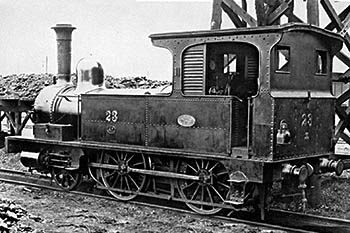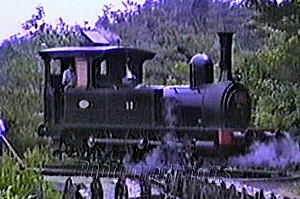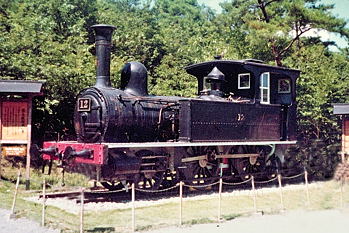Steam Locomotive
|

No.23 during it's active service days 1874-1909. (I.W.collection) |
|
Two years after the opening of the Japanese railway between Shinbashi and Yokohama, two more engines were added in 1874. The added engines were the efficient No.2-5s from the list above and were from the Sharp Stewart Co. And their manufactured numbers were 2420 and 2421. These were named No.22 and 23. After their arrival in Japan, both engines were used in the Tokyo area from January - June 1875. The Tokyo area engine numbers were changed to odd numbers during 1876. So, No.22 was changed to No.21. (No.23 was not changed). After a long period of time, both engines were active at Shinbashi in Tokyo. Afterward, their class name was changed to Class 160 with four other Sharp Stewart's No.13,15,17 and 19 (ex-No.2-5), they were named ; No.21 (ex-No.22) to No.164, No.23 to No.165. And later they were moved to the Osaka area. On the 31st of January 1911, No.164 and 165 were later exchanged with No.2 (later named to class 2850 No.2852) and No.3 (later named to class 600 No.673) and moved to Bisai Railway and thier names were changed to Bisai Railway's No.11 and No.12. No.11 (ex-No.22) was retired and scrapped early before WW2. No.12 (ex-No.23) was restricted to yard work in Owari-Ichinomiya until 1952. And was later retired during October 1957. Due to its historical value and need for safekeeping, it was later preserved at the Meitetsu Line Park during 1963. Then, it was exhibited in the park's museum until the Museum Meiji-Mura opening. During 1965, No.12 was moved to the newly opened Meiji-Mura Museum. It was on Inactive-preservation status and later it was restored during 1973. No.12 became active as the steam train on the Meji-Mura line. The Boiler was restored during 1985. No.12 was the oldest restored steam engine in Japan. |
Biographic Data Chart No.23
|
| Configuration | 2-4-0 | Dimensions Length (mm) | 3683
| Engine Weight (Operating tons) | 21.69
| Driver size (mm diameter) | 1346
| Boiler pressure (Kg/cm2) | 8.4
| |

Restored years 1986, Meiji-Mura museum |
 During in inactive-preservation time. Meiji-Mura Museum 1968. |
Introduction
|
Go to Top
|